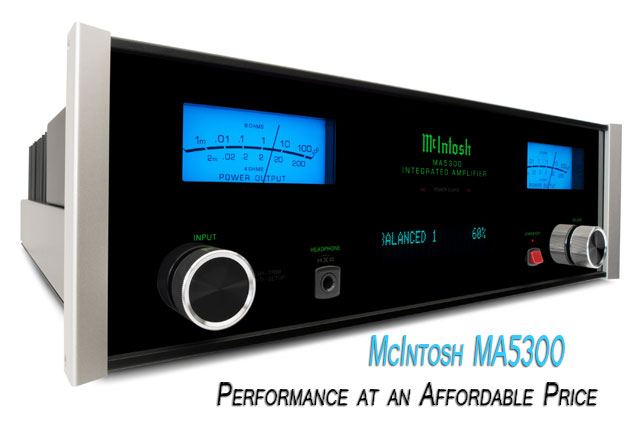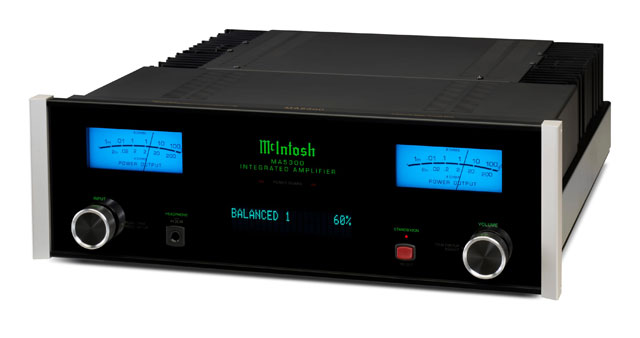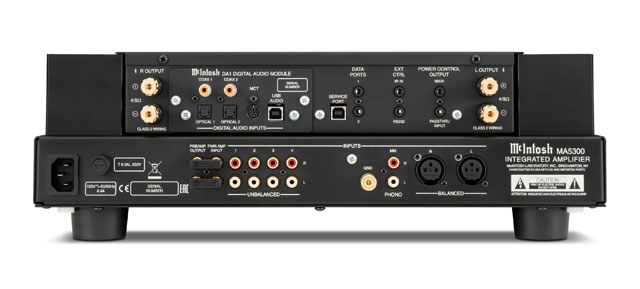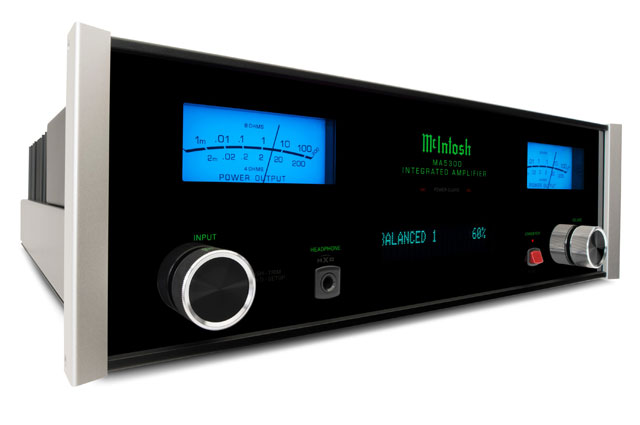McIntosh MA5300

 For me, owning McIntosh is a comforting feeling like a pair of favorite slippers or T-shirt. A McIntosh integrated amplifier was my first piece of real high-end equipment. I still remember it fondly. The McIntosh brand served me well then as well as today. Unfortunately I can’t say the same for some other brands. I have been “orphaned” five times by brands that were well-respected and widely-owned I watched other brands fall by the wayside. Some on the list would make an official Audiophile Hall of Fame if there was one. They represented an audiophile rite of passage. What happened to them? The stories are different but the results are the same, the brands and products are relegated to the history books and nostalgia.
For me, owning McIntosh is a comforting feeling like a pair of favorite slippers or T-shirt. A McIntosh integrated amplifier was my first piece of real high-end equipment. I still remember it fondly. The McIntosh brand served me well then as well as today. Unfortunately I can’t say the same for some other brands. I have been “orphaned” five times by brands that were well-respected and widely-owned I watched other brands fall by the wayside. Some on the list would make an official Audiophile Hall of Fame if there was one. They represented an audiophile rite of passage. What happened to them? The stories are different but the results are the same, the brands and products are relegated to the history books and nostalgia.
Why did McIntosh endure? Surely McIntosh today is not the same as the company founded in 1949 and it has undergone ownership changes. But somehow the fundamental philosophy was preserved. McIntosh stayed true to its core values of performance, long-term reliability, customer service, and dedicated dealer network. And that has garnered a loyal following that trust the philosophy will continue to guide McIntosh through its 70th anniversary year and beyond.
Moving into a new home allowed me to add a second high-end system. At the same time I decided to simplify each system and control total costs. Brand new homes are money pits inside and out. I also have a self-imposed (damaged shoulder) weight limit of less than 45 pounds. Tiring of the journey’s pitfalls (defunct companies, poor distribution, rapid product cycles, chasing new and “improved” editions) I have begun to appreciate secure destinations. McIntosh’s depth of resources and experience developing amplification products means they can get it right the first time and offer long model run times without the industry addiction to Signature or MKII “upgrades” later.


The MA5300 is a well-designed package offering analog, digital, and MM (MC if high output) phono inputs. Offering DAC functions in a product that can last decades can be a gamble in the ever-changing realm of digital. The MA5300 deals with that in two ways. First, it can handle all the current favorite formats via multiple input options (See Specifications). Second, the DA1 Digital Audio Module can be replaced by a consumer comfortable with a screw driver. It is the same module used in more expensive McIntosh models and its use in multiple products guarantees future availability and upgrades if needed. But don’t consider the DA1 a casual add-on like you might find in a home theater receiver. It is serious business with a quad balanced 8-channel, 32-bit/384kHz PCM/DSD, Digital-to-Analog Converter (DAC) with ESS Sabre Model 9016 chips utilized in an exclusive McIntosh balanced digital design with 4 DAC’s per channel.
 Other features in the MA5300 include single-ended preamplifier in/amplifier out connections, headphone output, power on/off trigger, and connectivity to other McIntosh products. Unused inputs can be removed from the scroll log. Level matching can be set between inputs to accommodate difference in source outputs. Also included are bass and treble tone controls (up to +/- 12dB) and a home theater pass through. The headphone amplifier has an impedance of 100 to 600 Ohms and includes McIntosh’s defeatable Headphone Crossfeed Director (HXD®). Electromagnetic switches on all inputs and operating functions provide reliable, noiseless, distortion free switching. The MA5300 has a defeatable automatic-off feature that puts the unit into standby if there is no signal input or activity from the user.
Other features in the MA5300 include single-ended preamplifier in/amplifier out connections, headphone output, power on/off trigger, and connectivity to other McIntosh products. Unused inputs can be removed from the scroll log. Level matching can be set between inputs to accommodate difference in source outputs. Also included are bass and treble tone controls (up to +/- 12dB) and a home theater pass through. The headphone amplifier has an impedance of 100 to 600 Ohms and includes McIntosh’s defeatable Headphone Crossfeed Director (HXD®). Electromagnetic switches on all inputs and operating functions provide reliable, noiseless, distortion free switching. The MA5300 has a defeatable automatic-off feature that puts the unit into standby if there is no signal input or activity from the user.
The patented McIntosh Power Guard® circuit prevents amp clipping to protect loudspeakers. Small indicator lights under the McIntosh logo momentarily illuminate when Power Guard® is activated during peaks in the audio signals. Built in thermal protection circuits prevent overheating and will activate muting and constant illumination of the indicator lights. A large power transformer, 60 Joules energy storage, and regulated power supply maintain stable, noise-free operation despite power input fluctuation. High current output transistors eliminate warm-up time. Gold-plated binding posts accept spades, bare wire, and banana plugs (USA and Canada).
In the center of the remote is a “Select Trim” function button. Engaging it enables scrolling through a menu that allows the listener to adjust treble, bass, balance, and the display. These functions can also be accessed via pressing the left knob on the unit. Turning that knob selects inputs. The right knob controls on/off/volume and is used to change settings in conjunction with the left knob.

 The front of the MA5300 is graced with the traditional McIntosh glass face plate and blue power meters. The display is large enough to be read from the listening position. Its brightness can be adjusted or the display can be turned off completely. I find the meter size on the MA5300 is “Goldilocks”, neither too large nor too small. Meter illumination can be turned off if desired but where’s the fun in that? The meters are peak responding and are marked in 10X increments from 1 milliwatt to 200 watts. This puts the 1W mark just right of center on the meter. This initially freaked me out because my ARC Reference-75 was calibrated so 1 watt had the needle not far from the left peg.
The front of the MA5300 is graced with the traditional McIntosh glass face plate and blue power meters. The display is large enough to be read from the listening position. Its brightness can be adjusted or the display can be turned off completely. I find the meter size on the MA5300 is “Goldilocks”, neither too large nor too small. Meter illumination can be turned off if desired but where’s the fun in that? The meters are peak responding and are marked in 10X increments from 1 milliwatt to 200 watts. This puts the 1W mark just right of center on the meter. This initially freaked me out because my ARC Reference-75 was calibrated so 1 watt had the needle not far from the left peg.
Rubber on the Road
No item can be evaluated independent of the system it is in. I used the MA5300 in two separate systems. I broke it in on my main system where it was planned for. During the 7 months while I waited for my Magico A3 speakers (4 ohms, 88dB efficiency) to be built I prepared the nursery. In my many times at CES and other audio shows precious few rooms stood out. One memorable room was all Audience including their 8-drivers per side line arrays. I did not hesitate to choose Audience’s new flagship line, Front Row, for interconnects, speaker cable, and power cord for the new system. They were fronted by an Audience Adept Response aR6-TSSOX power conditioner. My comments on the MA5300’s performance on the Magico speakers should not discount the contribution of the Audience products. Likewise, based upon past experience and reaffirmed with the A3s, IsoAcoustic GAIA II isolation feet contributed to improved bass and midrange performance by coupling the speakers to the ceramic tile floor. My great room is 18’x37′ with speakers on the long wall and the hot seat almost 14′ from the speakers. The seating area has padded carpet.
 Because the A3s are rated down to 22Hz I had to try “Poem of Chinese Drum” from the HDCD-mastered CD Poems of Thunder by Yim Hok-Man [Naxos World 76002-2]. While not something most people would want to listen to often, I find it an excellent test CD. Since Magico developed the A3 using more expensive and more powerful amplifiers than the MA5300 I wondered if it would be powerful enough. After playing a couple of tracks from this CD my concern was allayed. The MA5300 was more than up to the challenge. It passed with flying colors. I was surprised at the quality and quantity of the bass output from such small speakers. Actually surprised is quite an understatement. My response was more like holy ____! I was not expecting that. My existing enthusiasm for the MA5300 was increased considerably. Good bass requires more than just power. It also requires control and the MA5300 exhibited excellent control with powerful strikes and defined decay as the drum head vibrations decreased. The McIntosh/Magico combination produced subwoofer bass quantities and frequencies but with the added benefits of better definition and seamless integration.
Because the A3s are rated down to 22Hz I had to try “Poem of Chinese Drum” from the HDCD-mastered CD Poems of Thunder by Yim Hok-Man [Naxos World 76002-2]. While not something most people would want to listen to often, I find it an excellent test CD. Since Magico developed the A3 using more expensive and more powerful amplifiers than the MA5300 I wondered if it would be powerful enough. After playing a couple of tracks from this CD my concern was allayed. The MA5300 was more than up to the challenge. It passed with flying colors. I was surprised at the quality and quantity of the bass output from such small speakers. Actually surprised is quite an understatement. My response was more like holy ____! I was not expecting that. My existing enthusiasm for the MA5300 was increased considerably. Good bass requires more than just power. It also requires control and the MA5300 exhibited excellent control with powerful strikes and defined decay as the drum head vibrations decreased. The McIntosh/Magico combination produced subwoofer bass quantities and frequencies but with the added benefits of better definition and seamless integration.
I did get the MA5300 Power Guard® indicator lights to blink during cannon fire on the DVD Pirates of the Caribbean: The Curse of the Black Pearl [Disney 31663]. But it was a totally unfair test. The cannon fire was unbearably loud and the movie was playing in 2-channel making the amp and speaker perform what is normally the task for a separate subwoofer(s) and dedicated amplification. Nevertheless, the performance was exceptional. I did not desire more power because I was reaching for the remote to turn the volume down–a lot! This was using the MA5300 DAC module via the optical output from my LG OLED TV.
 I have had mixed experience with Magico speakers at audio shows. As a Quad owner/lover I appreciated Magico’s precision and detail but they frequently left me wanting for a more emotional attachment. Not so with the A3s and McIntosh. I found the combination very engaging. Although a steadfast devotee of all open baffle designs (dynamic, planar-magnetic, electrostatic), I found that if placement issues prevented their use, going completely opposite to sealed speakers was a good option. The A3s are so new to me I have no reference with other amps on the speakers to comment on how the MA5300 compares but I can say I am very happy with the combination.
I have had mixed experience with Magico speakers at audio shows. As a Quad owner/lover I appreciated Magico’s precision and detail but they frequently left me wanting for a more emotional attachment. Not so with the A3s and McIntosh. I found the combination very engaging. Although a steadfast devotee of all open baffle designs (dynamic, planar-magnetic, electrostatic), I found that if placement issues prevented their use, going completely opposite to sealed speakers was a good option. The A3s are so new to me I have no reference with other amps on the speakers to comment on how the MA5300 compares but I can say I am very happy with the combination.
I moved the MA5300 to my longtime reference system comprised of Quad ESL-2805 speakers (4-15 Ohms, 86dB efficiency) with JPS Labs Aluminata speaker cables, interconnects, and power cords. Speakers are spiked through carpet onto concrete. Power conditioning is provided by a Bybee Stealth power conditioner. I used my Laufer-Teknik Memory Player 64 (32-core) as the source for both systems for continuity.
What I heard revealed the MA5300 did exactly what an amplifier is supposed to do. It did a fine job accurately portraying everything I played without exaggeration or calling attention to itself. I have experienced some amplifiers having problems with the 4-15 Ohm swing of the Quads and sounding lackluster or confused but the MA5300 was unfazed.
 Unlike many modern performers, Jennifer Warnes does not need heavy instrumentation to cover a lack of vocal talent. On the track “If it Be Your Will” from her CD Famous Blue Raincoat 20th Anniversary Edition [Shout Factory LLC, 826663-10490] instrumentation is delicate and complementary, enhancing the vocals but not masking them even when Jennifer’s voice fades to barely a whisper. The MA5300 defines each instrument while still blending them into the delicate backdrop for Jenifer’s voice. I have heard other amplifiers on my speakers define the instruments clearly but somehow lose the music and my interest. The MA5300 did not lose the music and I found myself repeating my favorite tracks.
Unlike many modern performers, Jennifer Warnes does not need heavy instrumentation to cover a lack of vocal talent. On the track “If it Be Your Will” from her CD Famous Blue Raincoat 20th Anniversary Edition [Shout Factory LLC, 826663-10490] instrumentation is delicate and complementary, enhancing the vocals but not masking them even when Jennifer’s voice fades to barely a whisper. The MA5300 defines each instrument while still blending them into the delicate backdrop for Jenifer’s voice. I have heard other amplifiers on my speakers define the instruments clearly but somehow lose the music and my interest. The MA5300 did not lose the music and I found myself repeating my favorite tracks.
 Moving from mild to wild, rodrigo y gabriela romp and stomp (literally), maintaining a blistering pace all the way through the high energy live performance captured on their CD Live in Japan [ATO Records ATO0062 88088-21638-2]. The MA5300 matched their pace and gave me more volume that I wanted while never passing 18 watts.
Moving from mild to wild, rodrigo y gabriela romp and stomp (literally), maintaining a blistering pace all the way through the high energy live performance captured on their CD Live in Japan [ATO Records ATO0062 88088-21638-2]. The MA5300 matched their pace and gave me more volume that I wanted while never passing 18 watts.
My Laufer-Teknik Memory Player has both digital and analog outputs. For analog I used the balanced outputs. For digital I used the unbalance coaxial output because the MA5300 DAC module does not have a balanced AES/EBU input. I used the MA5300’s input level balance feature to reduce the digital input 5%. I found the sound using the MA5300 DAC module to be a little more forward and sharper than the analog input. My preference varied by song but generally I preferred the warmth of the analog input. The differences were slight and someone could easily prefer the digital input depending on personal taste, speakers, and music choice. The DAC also worked very well using the optical feed from my LG OLED TV. Yea, even on cannon fire.
Conclusion:
Although the MA5300 may be one of the smaller and less expensive McIntosh products make no mistake about its abilities. Seven decades of reputation for pride in craftsmanship and performance are something McIntosh takes seriously. Those decades of experience in design and manufacturing are packed into the MA5300. Considering the next more powerful integrated amplifier in the McIntosh line weighs a whopping 75 pounds, the MA5300 size and price becomes even more attractive. I used it on two widely different speaker designs and could not find fault. While the MA5300 does not stand out in any particular area of performance, neither does it fall down. It is a solid performer and a great choice for the core of an outstanding system where it will outlive many of the other components and never go out of style.

![]()
don shaulis
Specifications:
MSRP: $5500
Power Output: 100 Wpc (8 Ohms) 160 Wpc (4 Ohms)
Rated Power Band: 20Hz to 20kHz
Analog Inputs: 4 pairs unbalanced, 1 pair balanced, 1 pair phonograph moving magnet (fixed loading)
Digital Inputs: 2 coaxial, 2 optical, 1 USB, 1 Digital MCT (DIN)
Preamplifier output: unbalanced variable
Headphone output: 1/4″ High Drive with Headphone Crossfeed Director (HXD®)
Home Theater PassThru
Dynamic Headroom:1.8dB
Frequency Response: +0,-0.5dB 20Hz to 20kHz
Frequency Response: +0, -3dB 10Hz to 100kHz
Total Harmonic Distortion: 0.005%
Sensitivity Phono (Moving Magnet): 2.5mV
Sensitivity High Level: (Balanced / Unbalanced) 0.5V/0.25V
Sensitivity (Power Amp input): 1V
Signal To Noise Ratio (Moving Magnet): 82dB
Signal To Noise Ratio (High Level): 95dB
Signal To Noise Ratio (Power Amp input): 110dB
Input Impedance: (Balanced / Unbalanced) 20K/20K
Damping Factor: 8 Ohms: >200, 4 Ohms: >100
Maximum Output: 8V Unbalanced
Digital Audio Specifications:
Digital-to-Analog Converter (DAC) Type:
8-channel, 32-bit/384kHz PCM/DSD, Quad Balanced
Digital Coaxial Input Sample Rate: 24-bit/44.1kHz to 192kHz
Digital Optical Input Sample Rate: 24-bit/44.1kHz to 192kHz
Digital MCT (DIN) Input Sample Rate: 16-bit/44.1kHz (CD), DSD64 (SACD)
Digital USB Input Sample Rate: 32-bit/44.1kHz to 384kHz (PCM)
DSD64, DSD128, DSD256, DXD352.8kHz, DXD384kHz
Power Requirement:120V 50/60Hz, 2.3A
Standby Power Requirement:
Dimensions: (W x H x D) 17-1/2″ (44.45cm) x 6″ (15.24cm) x 22″ (55.88cm)
Weight: 38 lbs (17.2 kg)
Shipping Weight: 55.5 lbs (25.2 kg)
Address:
McIntosh Laboratory, Inc.
2 Chambers Street
Binghamton, NY 13903-2699
Telephone: 800 538 6576
Website: www.mcintoshlabs.com
Stereo Times Masthead
Publisher/Founder
Clement Perry
Editor
Dave Thomas
Senior Editors
Frank Alles, Mike Girardi, Key Kim, Russell Lichter, Terry London, Moreno Mitchell, Paul Szabady, Bill Wells, Mike Wright, Stephen Yan, and Rob Dockery
Current Contributors
David Abramson, Tim Barrall, Dave Allison, Ron Cook, Lewis Dardick, Dan Secula, Don Shaulis, Greg Simmons, Eric Teh, Greg Voth, Richard Willie, Ed Van Winkle, and Rob Dockery
Music Reviewers:
Carlos Sanchez, John Jonczyk, John Sprung and Russell Lichter
Site Management Clement Perry
Ad Designer: Martin Perry





Be the first to comment on: McIntosh MA5300